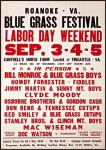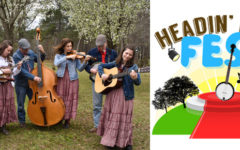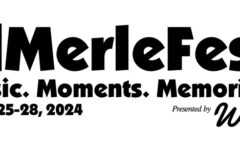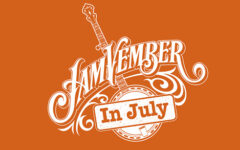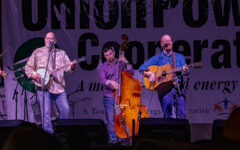
Starting on Friday, September 3, 1965, the first Fincastle Bluegrass Festival, in Fincastle, Virginia, took place.
“Wow, hard to believe it’s been fifty years ago … I was there for both of Carlton’s first multi-day festival in 1965 and 1966.” (Gary Henderson)
The first event held during Labor Day weekend was the first multi-day bluegrass festival and, unknowingly at the time, it became a trend-setter.
Staged at Cantrell’s Horse Farm, Fincastle, three-day event featured Bill Monroe and his Blue Grass Boys, Jimmy Martin and his Sunny Mountain Boys, Howdy Forrester, Clyde Moody, Don Reno and the Tennessee Cutups, Red Smiley and the Blue Grass Cutups, the Stanley Brothers and the Clinch Mountain Boys, Mac Wiseman and Doc Watson.
Although the Osborne Brothers were billed to appear, they did not actually do so. The brothers, with Gordon Cash, were contracted to appear in Texas.
 Planning for the event had been occupying organizer Carlton Haney’s mind for two years or more. He sought opinions, tested the market and did the practical tasks that were needed to make the festival happen. In staging this first multi-day bluegrass festival, he displayed considerable ingenuity, enterprise and bravery.
Planning for the event had been occupying organizer Carlton Haney’s mind for two years or more. He sought opinions, tested the market and did the practical tasks that were needed to make the festival happen. In staging this first multi-day bluegrass festival, he displayed considerable ingenuity, enterprise and bravery.
One of the highlights of the weekend was the Blue Grass Story, staged during the Sunday afternoon. Devised by Carlton Haney and using Bill Monroe as the focal point, Haney told the story of bluegrass as he presented a variety of combinations; Monroe with Clyde Moody, Monroe with Howdy Forrester; Monroe with Don Reno; Monroe with Mac Wiseman; and Monroe with Carter Stanley, all providing a reminder of the evolution of bluegrass music during the preceding 20 years.
A bluegrass music history site dedicated to the Camp Springs Blue Grass Park, Camp Springs, North Carolina, the location for Haney’s Labor Day Bluegrass Festival from 1969 onwards, has this rather blurred but nevertheless wonderfully historic 17 minute video clip that provides a taste of the music that day from Bill Monroe, Don Reno, Mac Wiseman, Benny Martin, Jimmy Martin, Bill Emerson
21-year old Gary Henderson remembers ..
“My memory fails to recall how I found out about the festival, but I do remember I went down with a couple of buddies, Dave Williams, a local dobro player in the DC area, and Dick Drevo, banjo player and owner of Urban Recording studio in Washington, DC, run out of his parent’s home in NW DC.
Dave drove down to Cantrell’s Horse farm in his new MG. And we “roughed it” for three days in a tent. It was terrible when we couldn’t shave or shower, but the good music made up for it. Ralph Rinzler, from the Smithsonian, was there with his Nagra tape recorder taping the entire festival.
Carlton’s history of the music (his Blue Grass Story) bringing sidemen together on the stage at different times was brilliant!”
Henderson has wonderful memories of all that the weekend had to offer, but he …..
“Had no idea the idea for a multi-day festival would continue, but everyone encouraged Carlton to promote more festivals.”
23-year old Peter Rowan, a Blue Grass Boy at the time of the festival, remembers …
“…….. this was the first time that all the bluegrass bands played on the same show. Jimmy Martin, the Stanley Bros, Mac Wiseman, and more.
I feel Kenny Baker [was there] for the first time at this event.
The bluegrass community turned out in force.”
Gene Lowinger, fiddle player with the Blue Grass Boys at the time, wrote of the weekend in his book I Hear A Voice Calling, published by the University of Illinois Press.
“The most historically significant shows I played as a Bluegrass <sic> Boy were at the Roanoke Bluegrass Festival. None of us in the band had a clue what would happen, but there was a modest turnout (by today’s standards) for all the shows. The setting was, to phrase it kindly, rustic. Security was maintained by Carlton Haney roaming the grounds with an honest-to-God, real life six-shooter wrapped around his waist in a cowboy holster. Never could tell what kind of problems would arise with all those hippie types (which included the likes of Sam Bush and David Grisman) attending.
……………….. Few of us had any idea of the influence on the musical culture that festival would have.
……….. This enterprise paved the way for other promoters to give a shot at multi-day, multi-band events. It spawned festivals such as Merlefest, the Winterhawk (now Greyfox) Festival, and a host of others.”
© University of Illinois Press / Gene Lowinger, 2009
In his highly recommended and wonderfully illustrated memoir, Lowinger went on to write about his fellow musicians and some of the songs that they played during their various sets.
14-year old Fred Bartenstein told Kurt Mosser in an interview for Bluegrass Unlimited, published in May 1999.
“I was working on a survey crew in Lexington in 1965, when I heard on the radio that there was going to be a big bluegrass festival at Cantrell’s Horse Park in Fincastle, Va. Freddie Goodhart, an old friend, drove me down with my Gibson J-50.” The first night Fred remembers sitting around picking with some other musicians when a drunk stumbled up and pulled a gun on him and Goodhart. “He said ‘play “Foggy Mountain Breakdown,” and if I don’t like the way you play it, I’ll blow your head off!’ He must have like the way we played it, because he gave us a beer afterward.”
“Bluegrass music had just been kicked out of country music at the time of that first festival. We all felt in ’65 that we were attending an Irish wake for bluegrass – for Monroe, the Stanleys, Jimmy Martin, Don Reno, Red Smiley, and Mac Wiseman.” Fortunately, things turned out much differently.”
© Bluegrass Unlimited magazine / Kurt Mosser
Fred Bartenstein and Fred Robbins have collaborated to set up a web presentation with some historic, making available ……
1) Bill Monroe’s contract with Carlton Haney for appearance at the event.
2) Mary Greenman Green’s 1973 Muleskinner News article on the event.
3) Relevant pages from the program of the 40th anniversary celebration held in Fincastle (including Phil Zimmerman’s SEBA article reprint).
4) The 26-minute DVD prepared for the 40th anniversary celebration in Fincastle. This video was provided courtesy of Historic Fincastle, Inc.
5) Ron Roach’s article on the Story of Bluegrass in Journal of Appalachian Studies.
6) Two one-hour audio files (in AAC m4a format) of the 1965 Story of Bluegrass. (Dubbed from Carlton Haney’s reel-to-reel tapes).
These audio recordings have been made available to WAMU’s Bluegrass Country and will be broadcast by them after Labor Day weekend. Listen for announcements.
Last month Ralph Berrier, Jr wrote with a local perspective about the 1965 Fincastle festival for the Roanoke Times.
Another website with some interesting aspects is Phil Zimmerman’s Bluegrass Time.
Richard Hawkins in his Bluegrass Ireland Blog…
“From that point the term ‘bluegrass festival’ became increasingly popular, and the number of such events rapidly grew to where the festival circuit became an important factor in musicians’ careers.”
And it all started on small horse farm just north of Roanoke, VA.

